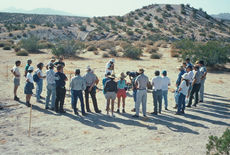
Biography of a Sustainability Leader
Pioneering Sustainability
My father was an engineer, scientist, inventor, fabricator, designer, prospector, and adventurer. In his heart of hearts, he wanted to be Robinson Crusoe. My mother was an environmentalist and superb oil painter specializing in Western landscapes. She suffered from agoraphobia. I inherited the complex mix of both. I eventually discovered I had inherited sensory processing disorder (SPD) from my mother. In retrospect, I could see that my hypersensitivity to sound, crowding, smells, lights, touch, and textures affected many of my decisions and challenges. It explained why I had always removed labels, worn shorts, soft shirts, and avoided crowds and office buildings.
I applied my skills and limitations to the challenge I gave myself early in my career — the search for sustainability. As a person with SPD I was best at pathfinding and pioneering -- not in settling, civilizing, promoting, politicking, or regulating. As soon as I became comfortable with what I knew (or thought I knew) about a particular topic I was eager to head for the next frontier. This approach has kept me engaged and passionate about my work and led to many insights from crossovers and linkages that might otherwise be missed. I have always begun my work with a careful review of past developments and research. The challenges of energy, food, water, and shelter are not new and much can be learned from what others have done.
I have been fortunate to work with many other innovators searching for sustainable solutions to everyday needs and long-term survival. My thanks to all. Their help, insights, and friendship have been pivotal in my growing understanding of the complexity of environmental and social systems and the great opportunities we have (and too often neglect) to improve sustainability.
Download David A. Bainbridge Curriculum Vitae
1970s
One of my first projects was a report on protecting the coastal lagoons of San Diego (1970), this led to many more including the first state workshop on environmental impact analysis (1972). I built one of the first sit-on-top kayaks (1974). My research on street widths and passive solar systems helped with the innovative Village Homes solar subdivision (1976), the use of first steel tank water wall, the first passive solar tax credit guidelines for a state, California (1978), and the first economics based quantitative land capability analysis report, US Geological Survey (1979).
1980s
I was a contributor to the first passive solar handbook for California (1980) and consultant for the first passive solar super-insulated home at Lake Tahoe (1981). I developed and used a low cost solar simulator (1983). I designed, built and used a-sit-on top conversion for my windsurfer (1984). I prepared the first modern review of straw bale construction (1986) and the first American report on super-efficient irrigation systems. This included buried clay pot, “olla,”irrigation (1987). My experiments on removal of selenium from contaminated soil with leguminous trees were succesful (1988). I helped with the first modern straw bale workshop, Oracle AZ (1989). I participated in the first workshop on agroforestry in California (1989), and this led to one of the first reports on agroforestry for California (1989) and the United States (1997). I was invited to China on an agroforestry exchange program (1989),
1990s
I was coauthor of the first book on sustainable agriculture for California with Steve Mitchell (1991), and editor of the first report on climate change impacts in Mexico (1991). I invented and refined low-cost soil penetrometers (1991) and soil infiltrometers (1992). I organized and co-taught the first desert restoration workshop for the Society for Ecological Restoration (1993). I also helped set up, and wrote up, papers from the First International Straw Bale Building Conference in Arthur, Nebraska (1993). This helped lead to the first big book on straw bale construction with Bill and Athena Steen and David Eisenberg (1994). I wrote the first National Park Guide to Desert Restoration (1995).
2000s
I presented a paper at the First International Conference on Ecocomposite Materials (2001) and provided the first economic assessment of nitrogen pollution at the US Society of Ecological Economics Conference (2002). I was awarded the ASES Passive Solar Pioneer Award (2004). I wrote one of the first American books with a chapter on true cost accounting (2007). This led to work advising one of my students as she created the first firm offering Global Reporting Initiative training in the United States (2009). I also co-authored the first International Solar Energy Society Passive Solar Pocket Reference Guide with Ken Haggard (2009).
2010s
I was co-organizer of the first North American Conference on Environmental and Sustainability Management Accounting EMAN (2010). I also prepared a series of papers on super-efficient irrigation. I co-wrote the comprehensive book on Passive Solar Architecture (2011) with Ken Haggard and Rachel Aljilani. In 2011 my work on super-efficient irrigation led to the award-winning book, Gardening with Less Water (2015).
2020s
I was finally able to write up my work on the impacts of the fur trade on western North America (2020, 2021). I wrote the biography of my cousin, Kenneth, a key player in World War 2 for his work on radar and the director of the first atomic bomb test (2022). Today (2022) my work is focused on the critical challenge of True Cost Accounting. My current book project, “Accountability” will be out in early 2023. It completes the work I started back in 1983 when I wrote about the true cost of agriculture for the first time.
"I intend to stay on the frontier... it is still the most fun and there is still much to be done and much to be learned!"
-- David Bainbridge














